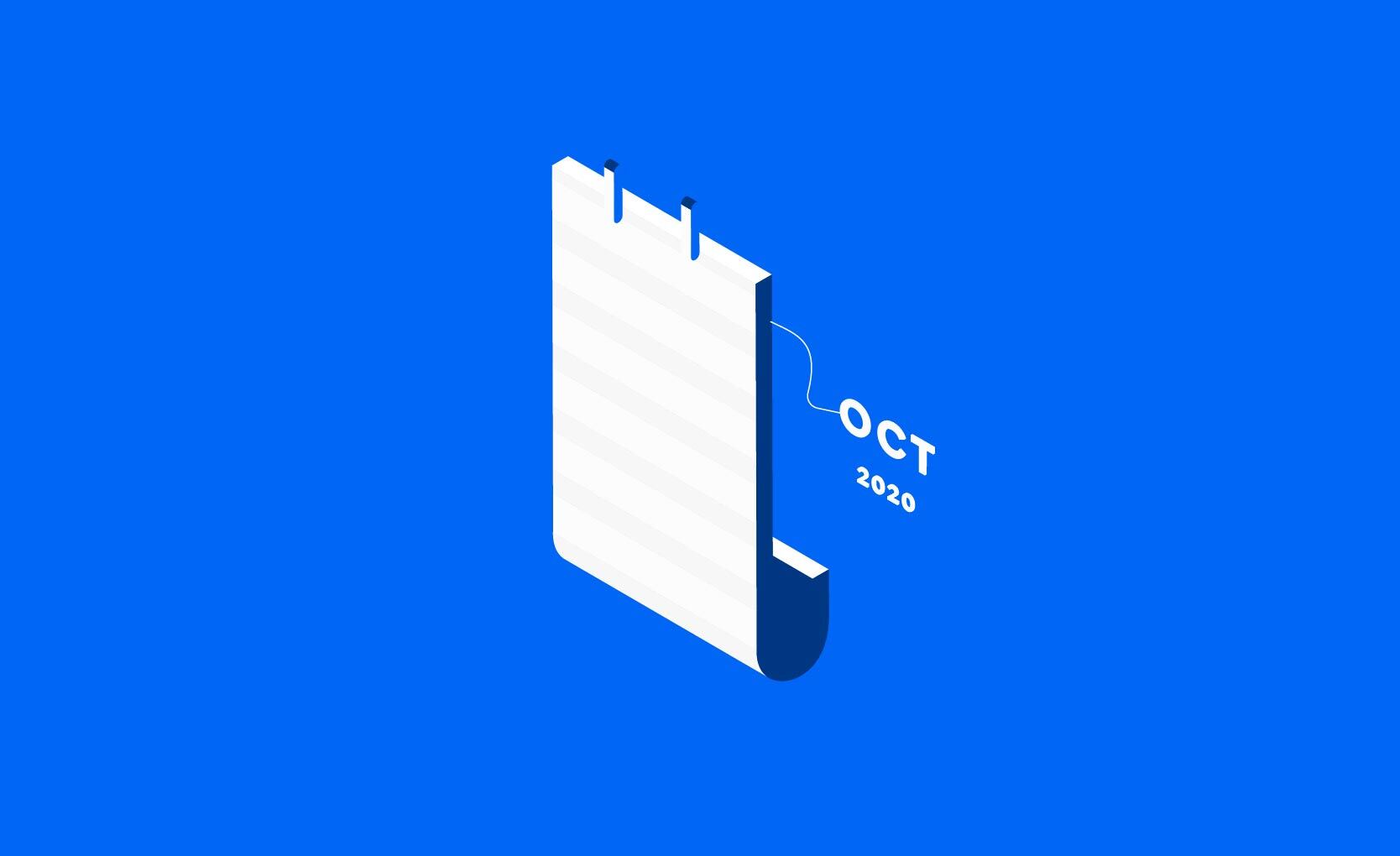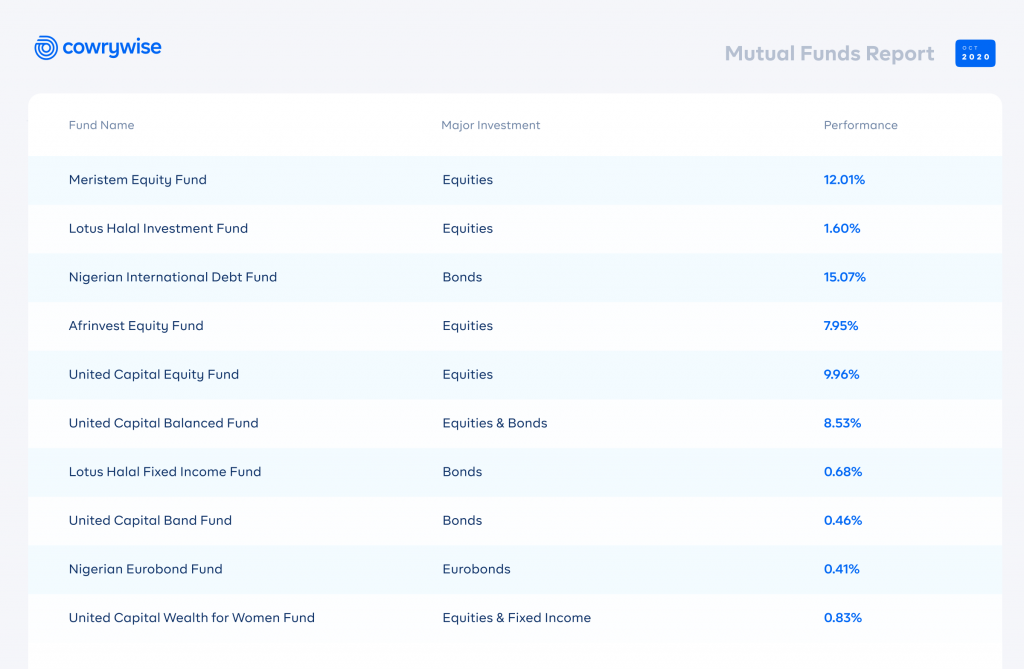
Market slice is a monthly summary of mutual funds on Cowrywise and key money news. This jargon-free report is shared on the 3rd of every month. Share lessons using the hashtag: #MarketSlice
Hey ??
We started off November with grumbles about the price of onions, which increased by 285%. Later into the article, you’ll understand why this happened. But let’s see how mutual funds performed in October first, the month we united to speak up against police brutality ✊?.
How Mutual Funds Performed in October 2020
The table below lists the returns of mutual funds in October–based on price changes. The next paragraph explains the magic behind the calculation. ?

Assume you own 10 units of a mutual fund. If the selling price of each unit was ₦100 on October 1 and ₦105 on October 30, you have gained 5%. That is because ₦5 is 5% of ₦100, and each unit now costs ₦5 extra.
Using the same approach, we examined the sell prices for the units of these funds as of October 1, 2020, and compared them with periods around October 30, 2020. Then, we did some math to show how much the units of each fund gained or lost. If you still do not get this, please drop a comment and we’ll explain.
Learn More: How do mutual funds work?
? Bond Funds: The Rain of Returns
Recently, funds that invested in bonds have had high performances. For example, the NIDF fund had a performance of 15% in October. Remember that performance is measured by the change in the unit price of the fund. If a unit costs ₦100 in September and ₦115 in October, the fund has gained ₦15 (15% of ₦100).
When entities, like the government, need money, they issue bonds. The initial price of the bond is determined by how much that entity needs, ₦100,000 for example. The issuer (entity lending the money) agrees to pay a set amount over an agreed period of time as interest.
If the agreed amount is ₦4,000 in this case, that amount, which cannot change, is called the coupon payment. However, there is another important term known as the yield to maturity (YTM). When a bond is issued, the YTM is the same thing as the coupon payment. So, for the above bond, the yield to maturity (YTM) is 4% (₦4,000 divided by ₦100,000). Here’s where things get interesting.
Since a bond is simply an agreement that qualifies one to receive coupon payments, it can be traded. If one chooses to sell the bond, bought at ₦100,000, many factors come into play but we’ll use a simple example to explain things. Take the YTM as the interest rate (currently 4%).
If the rate drops from 4% to 2%, the issuer still pays the agreed ₦4,000. But 2% of ₦100,000 is ₦2,000 so something isn’t right. To balance things, when rates drop the prices of bonds increase and vice-versa. Hence, at a 2% rate, the price of the bond jumps to ₦200,000 (2% of this gives us ₦4,000). The reality is more complex but this is a basic example.
Imagine an Ali bought the bond at ₦100,000. Now that the rate has dropped to 2%, he can sell the bond to John for ₦200,000. It doesn’t mean the government is borrowing more, the selling value just changed because of the rate drop. Think of this as buying an item and reselling for a higher or lower value.

The Conclusion?
The price and interest rate (called yield to maturity) move in opposite directions. If the yield increases, the prices drop and vice-versa. The reason for the heavy jump in bond funds like the NIDF is due to the increase in price, which is driven by the recent drop in bond yields.
? Equity Funds: Not Slowing Down
People shy away from equities (stocks), as they are termed as high-risk. Also, picking the right stocks is no easy task. It is for this reason that equity mutual funds exist–professionals help pick stocks and spread your risk. When the stocks in these funds perform well, they also perform well and vice-versa. You invest and the fund manager takes on the stress.
Last month, we reported that equities were making a bull run in Nigeria (the report explains in detail what a bull run is). This means that the stock market gained money. The story didn’t change in October, despite a slow dance mid-way through the month. One equity fund gained 12% in October. ?
Check this: We have the highest collection of Nigerian mutual funds
⚠️ Just before you rush to get some units, equity funds are for the long-term play. The best way to invest in them is via automated deposits of a set amount over time. For example, ₦50,000/month. Finally, it is possible to lose money with equity funds.
? Data snap of the month
In May, a 50kg bag of onions was sold at ₦13,000. Today, it sells at ₦50,000*. That means the price increased by about 285%! Something similar happened last year–the price increased by 171% within the same period. Farmers, according to Business Day, plant onions this period (November to December). That is the stock of onions, given storage challenges, is heavily depleted at this time till the next harvest.
However, reports from Hum Angle and Bloomberg suggest that COVID-19, floods in states like Kebbi (a major producer of onions) recent unrests have also contributed to the spike. So, asides from the expected annual scarcity in this period, the prices are much higher than expected because of these.
For this data point, we interviewed frequent customers of the Lagos Mile 12 food market and Emmanuel Odanye, an agricultural consultant in northern Nigeria.
Your favourite advisor,
Ope ?
